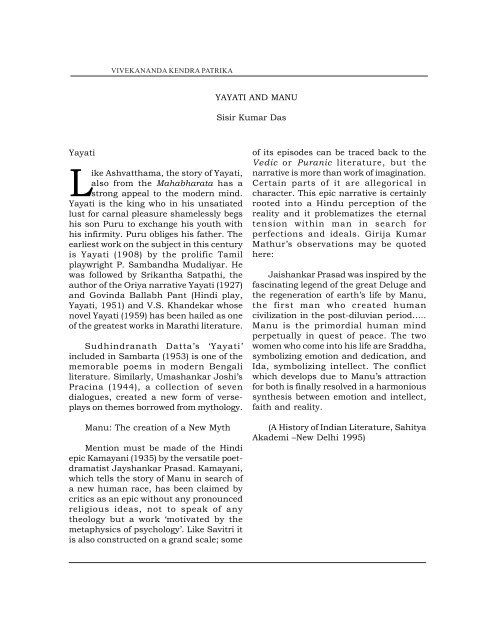Epics in Imprints-1.pdf - Vivekananda Kendra Prakashan
Epics in Imprints-1.pdf - Vivekananda Kendra Prakashan
Epics in Imprints-1.pdf - Vivekananda Kendra Prakashan
Create successful ePaper yourself
Turn your PDF publications into a flip-book with our unique Google optimized e-Paper software.
Yayati<br />
VIVEKANANDA KENDRA PATRIKA<br />
Like Ashvatthama, the story of Yayati,<br />
also from the Mahabharata has a<br />
strong appeal to the modern m<strong>in</strong>d.<br />
Yayati is the k<strong>in</strong>g who <strong>in</strong> his unsatiated<br />
lust for carnal pleasure shamelessly begs<br />
his son Puru to exchange his youth with<br />
his <strong>in</strong>firmity. Puru obliges his father. The<br />
earliest work on the subject <strong>in</strong> this century<br />
is Yayati (1908) by the prolific Tamil<br />
playwright P. Sambandha Mudaliyar. He<br />
was followed by Srikantha Satpathi, the<br />
author of the Oriya narrative Yayati (1927)<br />
and Gov<strong>in</strong>da Ballabh Pant (H<strong>in</strong>di play,<br />
Yayati, 1951) and V.S. Khandekar whose<br />
novel Yayati (1959) has been hailed as one<br />
of the greatest works <strong>in</strong> Marathi literature.<br />
Sudh<strong>in</strong>dranath Datta’s ‘Yayati’<br />
<strong>in</strong>cluded <strong>in</strong> Sambarta (1953) is one of the<br />
memorable poems <strong>in</strong> modern Bengali<br />
literature. Similarly, Umashankar Joshi’s<br />
Prac<strong>in</strong>a (1944), a collection of seven<br />
dialogues, created a new form of verseplays<br />
on themes borrowed from mythology.<br />
Manu: The creation of a New Myth<br />
Mention must be made of the H<strong>in</strong>di<br />
epic Kamayani (1935) by the versatile poetdramatist<br />
Jayshankar Prasad. Kamayani,<br />
which tells the story of Manu <strong>in</strong> search of<br />
a new human race, has been claimed by<br />
critics as an epic without any pronounced<br />
religious ideas, not to speak of any<br />
theology but a work ‘motivated by the<br />
metaphysics of psychology’. Like Savitri it<br />
is also constructed on a grand scale; some<br />
YAYATI AND MANU<br />
Sisir Kumar Das<br />
of its episodes can be traced back to the<br />
Vedic or Puranic literature, but the<br />
narrative is more than work of imag<strong>in</strong>ation.<br />
Certa<strong>in</strong> parts of it are allegorical <strong>in</strong><br />
character. This epic narrative is certa<strong>in</strong>ly<br />
rooted <strong>in</strong>to a H<strong>in</strong>du perception of the<br />
reality and it problematizes the eternal<br />
tension with<strong>in</strong> man <strong>in</strong> search for<br />
perfections and ideals. Girija Kumar<br />
Mathur’s observations may be quoted<br />
here:<br />
Jaishankar Prasad was <strong>in</strong>spired by the<br />
fasc<strong>in</strong>at<strong>in</strong>g legend of the great Deluge and<br />
the regeneration of earth’s life by Manu,<br />
the first man who created human<br />
civilization <strong>in</strong> the post-diluvian period…..<br />
Manu is the primordial human m<strong>in</strong>d<br />
perpetually <strong>in</strong> quest of peace. The two<br />
women who come <strong>in</strong>to his life are Sraddha,<br />
symboliz<strong>in</strong>g emotion and dedication, and<br />
Ida, symboliz<strong>in</strong>g <strong>in</strong>tellect. The conflict<br />
which develops due to Manu’s attraction<br />
for both is f<strong>in</strong>ally resolved <strong>in</strong> a harmonious<br />
synthesis between emotion and <strong>in</strong>tellect,<br />
faith and reality.<br />
(A History of Indian Literature, Sahitya<br />
Akademi –New Delhi 1995)

















